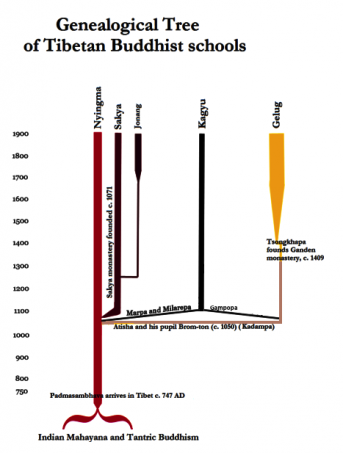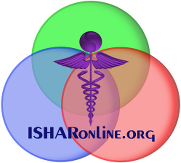New Uploads: Full-text Tibetan Buddhism Books
As part of its mission to provide open access to all scholarly aspects of the mind-body subject, ISHAR regularly makes full-text historical books available to our users. We've uploaded another three books to our Tibetan books page, along with brief summaries of the texts and Tibetan literature in general, compiled by Dr. William Bushell.
Bardo Thodol or Tibetan Book of the Dead
The Bardo Thodol (Tibetan: བར་དོ་ཐོས་གྲོལ, Wylie: bar do thos grol), Liberation Through Hearing During the Intermediate State, is a text from a larger corpus of teachings, the Profound Dharma of Self-Liberation through the Intention of the Peaceful and Wrathful Ones, revealed by Karma Lingpa (1326–1386). It is the best-known work of Nyingma literature, and is known in the West as the Tibetan Book of the Dead. The Tibetan text describes, and is intended to guide one through, the experiences that the consciousness has after death, in the bardo, the interval between death and the next rebirth. The text also includes chapters on the signs of death and rituals to undertake when death is closing in or has taken place.
Illumination of the Path to Freedom
Illumination of the Path to Freedom by His Holiness the First Dalai Lama Gyalwa Gendun Drup (1391-1474), is a commentary to a much older Tibetan classic: The Treasure House of Knowledge, written by the Master Vasubandhu (350 AD). Dalai Lama starts out with an entertaining discussion about Tibetan versus Sanskrit – Tibet versus India:
“If a commentary comes from India people will take the time to study and teach it. It’s just like the local merchants. If they hear some barley has come from the lowlands, right away they want to trade for it, because the source is a good one. A commentary may be excellent, but if you don’t put some Sanskrit in it nobody wants to work with it. They think it’s just Tibetan.”
Praises to the Twenty One Taras
Tara (Sanskrit: तारा, tārā; Tib. སྒྲོལ་མ, Dölma) or Ārya Tārā, also known as Jetsun Dölma (Tibetan language:rje btsun sgrol ma) in Tibetan Buddhism, is a female Bodhisattva in Mahayana Buddhism who appears as a female Buddha in Vajrayana Buddhism. She is known as the "mother of liberation", and represents the virtues of success in work and achievements. She is known as Tara Bosatsu (多羅菩薩) in Japan, and occasionally as Duōluó Púsà (多羅菩薩) in Chinese Buddhism. Tara is a tantric meditation deity whose practice is used by practitioners of the Tibetan branch of Vajrayana Buddhism to develop certain inner qualities and understand outer, inner and secret teachings about compassion and emptiness. Tara is actually the generic name for a set of Buddhas or bodhisattvas of similar aspect. These may more properly be understood as different aspects of the same quality, as bodhisattvas are often considered metaphors for Buddhist virtues.

Tibetan Literature
The Tibetan script was developed from an Indic script in the 7th century during the Tibetan Imperial period. Literature in the Tibetan language received its first impetus in the 8th century with the establishment of the monastic university Samye for the purpose of the translation of the voluminous Buddhist texts from Sanskrit into the vernacular. The Tibetan absorption of Buddhist thought allowed for the penetration of Chinese as well as Indian styles, through representations of the Arhat. In their final form, established in the 14th and 17th centuries respectively, these texts comprise the 108-volume Kangyur, and its 224-volume commentary, the Tengyur. Because of the destruction of the monastic universities of India by the Mughals, the Tibetan versions of some works are the only extant ones. Around 950, a secret library was created in the Mogao Caves near the oasis of Dunhuang to protect Buddhist scriptures, and it is by this means that we possess many of the oldest versions of some Tibetan, Chinese and Uighur texts.
Throughout most of Tibetan history, its literary works have been strongly influenced by Buddhist thought: they are mostly religious, historical, and biographical texts, or a mixture of these genres. There are also collections of folktales (for example, those involving the trickster figure Akhu Tönpa), and works dealing with the ancient Bön religion, which preceded Tibetan Buddhism. Particularly well known in the West are the Tibetan Book of the Dead, translated into English in 1927, the 120-volume Epic of King Gesar, one of the few living epics, and The Tale of the Incomparable Prince by Tshe-rin-dban-rgyal (1697–1763), translated into English in 1996. The Gesar epic in particular is the key subject of study by the Chinese state, and was revived with the end of the clergy's monopoly on political power, since the Gelugpa monasteries forbade the epic literary genre.[3]

Modern era
After 1949, when China took power in Tibet, access to secular education was greatly expanded. As a result, Tibetan literature has now covered more diverse, non-monastic topics including social commentary. In 1980, the Tibet Autonomous Region Writers Association (TARWA) started the first Tibetan-language literature journal, Tibetan Literature and Art (Bod kyi rtsom rig sgyu rtsal), which published short stories about historical serfdom in Tibet. The most popular Tibetophone literary magazine in Qinghai, "Light Rain" (Drang Char), was founded in 1981, popularizing the short story genre in Tibet. After 1985, Tibetan journals also criticized the Gang of Four and the excesses of the Cultural Revolution, and were less bound by the constraints of political correctness. The influence of Chinese poetry, and of Western poetry in Chinese translation, began to make itself felt after the Four Modernizations. Despite these influences, critics and editors gave priority to stories and poems with traditional settings. Most new work takes the form of poetry.
The most influential Tibetan writers come from Qinghai rather than Tibet; these "Amdowa" writers include Dhondrup Gyal and Gedun Chophel, whose works were characteristic of modernism. Their works are featured in Tibetan-language textbooks used in the "Five Provinces" as part of China's unified education policy for all Tibetan-speaking areas of China. According to the exile historian Tsering Shakya, despite state monitoring, "Tibetan writers, intellectuals, and artists have been able through fiction to conduct an autonomous debate on the nature of Tibetan identity".
Modern Tibetan literature is influenced by the trends of Chinese literature as a whole because of intranational translation from Chinese into Tibetan; Tibetan-language literature is also translated into Chinese, but to a far lesser extent. The Catalogue of Chinese Publications in Tibetan Studies (1949-1991) lists 1,497 Tibetological publications, 813 in Chinese and 663 in Tibetan. Some well-known Tibetan writers who publish in both Chinese and Tibetan include Jangbu and Tsedor. Adding to the diversity of Tibetan literature are longtime Han Chinese residents of Tibet who were educated in Tibetan; these lao Xizang (Tibetan veterans) often publish literary criticism with nostalgic and sentimental overtones.
The literary scene since the 1990s generally organises itself in terms of small self-named groups of young writers, many of whom studied at Qinghai University in Xining. Among the first were the Four Demons of the Old Fort, followed by such groups as the Four Scholars, the Four Owl-Siblings of Rongwo, the Third Generation, etc. Within China the most promoted author is Alai (1959-), who writes in Chinese. Tashi Dawa, the vice-chairman of the TARWA, is another prominent Sinophone Tibetan writer.
Diaspora literature
Writers in the Tibetan diaspora also produce literature. The first literary journal of such writers was Jangzhon (1990–97), which was succeeded by several different independent periodicals; and the First National Conference of Tibetan Writers, organised by the Amnye Machen Institute, was held from 15–17 March 1995 at Dharamsala, India. Books in English have been written by exiles such as Bhuchung T. Sonam, Tsering Wangmo Dhompa, Jamyang Norbu and Tenzin Tsundue. Especially popular are autobiographies of Tibetans for an American and British audience. However, pressures from the popular expectations of Western readers for what Vincanne Adams calls the "authentic Tibetan" limit success to authors who identify themselves "as Buddhist, as nationalist, and as exiles". Tibetans who actually live in Tibet, or whose experience incorporates aspects of Chinese or Western culture, are seen to be "tainted".
References
- Kolas, Ashield; Thowsen, Monika P. (2005). On the Margins of Tibet: Cultural Survival on the Sino-Tibetan Frontier. pp. 40–41, 138–139.
- Richardson, Hugh (1983). Art of Tibet. Collection. University of California Press. p. 58.
- Blondeau, Anne-Marie; Buffetrille, Katia (2008). "What is the Chinese Government's Attitude Toward Traditional Tibetan Literature and Art?". Authenticating Tibet: Answers to China's 100 Questions. University of California Press. pp. 214–217.
- Hartley, Lauran; Schiaffini-Vedani, Patricia (2008). Modern Tibetan Literature and Social Change. Duke University Press. pp. 181–183.
- McMillin, Laurie Hovell (2002), "New Age Namtar: Tibetan Autobiographies in English", in Klieger, P. Christiaan, Tibet, Self, and the Tibetan Diaspora, Brill, pp. 156–157
External links
- Tibetan and Himalayan Library (THL) article
- Padmakara: The preservation, translation and publication of Tibetan literature
- First National Conference of Tibetan Writer
- Amnye Machen Institute
- The Translation of Buddhism in Tibet

